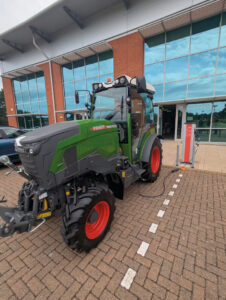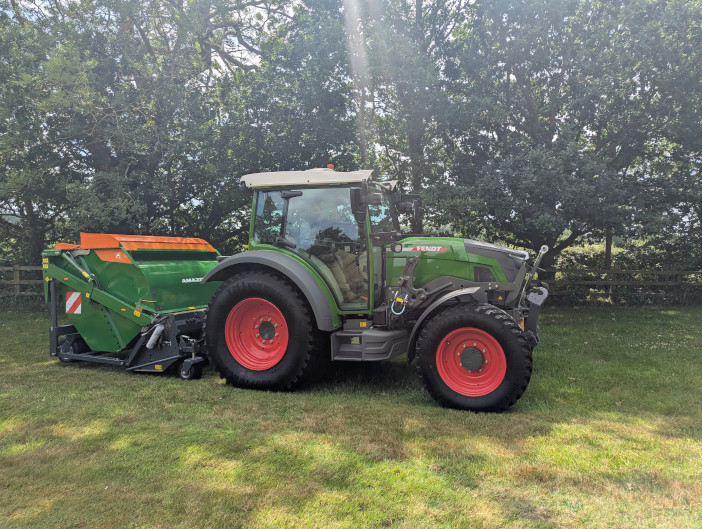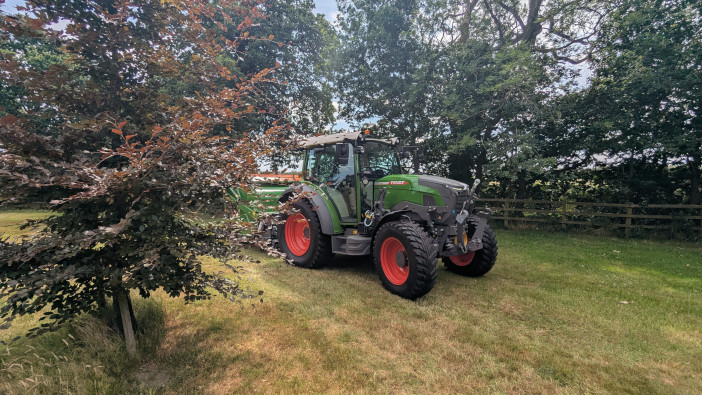Matt Tilt headed over to Stoneleigh to put the e100 Vario electric Fendt tractor through its paces
The e100 Vario tractor from Fendt is an interesting proposition. Based around the diesel-powered 200 Vario series, and available on both a standard chassis and a narrow body for vineyard and orchard work, the company isn’t necessarily pitching it directly at agriculture, but instead at agriculture-adjacent industries.
This means that while Fendt is not expecting to see the average farmer opt for one of these, at least not at the initial launch, there will be opportunities for those diversified into amenity and groundcare work to invest.
Part of this, explains Phil Mattey, tractor specialist, is the price tag. The added cost of integrating batteries, electric motors and refining the software results in a cost dangerously close to the £200,000 mark. Considering the power range that this machine fits into, it will no doubt be hard to justify for those not immediately obligated to go down the electric route.
For those who do, however, there’s a machine here with a lot of benefits. For starters, there is the instant availability of power. Unlike other alternative fuels, there is a decent infrastructure for electric and more opportunities for farms and rural businesses to be self-sufficient when it comes to procuring that energy.
When looking at the environmental benefits, Fendt estimates that the carbon dioxide reduction when compared to a standard diesel tractor is about 7.7t/year. While the whole electric market has been subject to a level of greenwashing – ignoring the carbon cost of mining lithium, shipping it for batteries, and the lack of recycling options – the company also gave us a figure of 950 hours for the e100 to become carbon neutral.
Combined with the noise reductions and the complete lack of tailpipe emissions, you have a machine that could suit operations in greenhouses and other under-roof areas, as well as being suitable for grass maintenance where there may be other people around.
“We still need that end-of-life infrastructure,” adds Phil. “However, we’ve done what we can to extend the working life of this machine. It comes with an eight-year, 8,000-hour warranty, and it is possible to replace individual sections of the battery to maintain the battery life over a longer period.”
 Direct power
Direct power
Under the bonnet, the e100 Vario has a prismatic lithium-ion battery, made up of 180 cells, with a capacity of 100kWh. The DC voltage from the battery is converted into three-phase AC current, which is transferred through a Danfoss electric motor.
In here, the RPM is downshifted to match that of the Vario 70/75 stepless gearbox. This is pretty much the only function that you can hear in the cabin until an implement is started up.
To maximise the working time, operators can choose from three power modes. Eco mode provides a 50kW output, equivalent to 68hp, which is designed to provide a maximum battery life while still conducting low intensity operations. Dynamic mode ups the power output to 55kW (75hp) for harder work, and the Dynamic+ mode boosts it to 66kW (90hp) for a limited period.
Further increasing the time between charges, the system can also recuperate up to 40kW when travelling downhill.
Three different charging options are available as well. There’s the option to plug the e100 Vario into the mains. This might be okay in extreme circumstances, but a full charge would take around 20 hours. A more likely option is the AC 22kW charger, where current is put through a built-in converter at the battery pack. This takes between four and five hours for a full charge.
A DC charger bypasses the converter, providing 80kW direct to the battery pack, and is capable of charging from 20% to 100% in less than an hour. While this saves time in the short term, not enough is known about regular fast charging’s long-term effect on the battery. If you take a mobile phone as a much smaller-scale example, fast charging is pretty much standard on every smart device now, but the batteries deteriorate in a couple of years if they are charged daily.
 A couple of neat touches have been added as well. Fendt-branded charging cables have a display so that operators can see the battery charge without climbing into the cab. Another feature that won’t be found on a diesel machine is the ability to set a departure time. With this, operators can set a start time, and the charging process will adapt and trickle charge to be full by this point. Once complete it will bring the battery up to operating temperature.
A couple of neat touches have been added as well. Fendt-branded charging cables have a display so that operators can see the battery charge without climbing into the cab. Another feature that won’t be found on a diesel machine is the ability to set a departure time. With this, operators can set a start time, and the charging process will adapt and trickle charge to be full by this point. Once complete it will bring the battery up to operating temperature.
Danger, high voltage
The introduction of high-voltage lines throughout the machine has led to increased safety measures. The most obvious is that when you open the bonnet, you don’t open the whole thing. You open a small section at the front, where you can see the reversible fan. The battery is completely closed off to the operator, and where you may see some cables, the high-voltage ones are clearly colour coded so that maintenance can be done safely.
On that note, maintenance costs will reportedly reduce by two-thirds. There are significantly fewer moving parts throughout the machine. Indeed, there is only the cab filter (changed at 500 hours) and some standard checks around the machine that need to be conducted. While it might not cover the added cost of the machine, this cost savings will add up over time.
Further to this, the routing of the air circulation has been changed to stop air gathering around the battery. Cold air is pulled in through the side grilles and split, with some pushed out of the front of the bonnet through a condenser, and the rest going through the condenser and out the top. As the airflow is split, it passes over either the air cooler or the oil cooler, limiting the amount of power needed for either of these.

A similar experience
When we were given the chance to get in the cab, we expected to have a host of questions to try to understand how this electric tractor operates. But honestly, for those who have driven a Fendt before, they’ll find a very familiar operating experience.
It brings down the FendtOne cabin, with the digital dashboard and a terminal integrated into the armrest. For the narrow version, this terminal is mounted into the roof. The control scheme is based on the Profi or Profi+ specification, with both offering the standard crossgate lever, rocker switches to control the hydraulics and configurable hotkeys. The Profi+ specification adds the 3L lever, which has a series of configurable controls with three layers of operation.
We quickly got to grips with the machine and started work with the Amazone GH-S groundkeeper mower collector. As you’d expect, all we could hear in the cabin was the sound of the mower working, and at about 8kph (admittedly a little slow, but we were in a small patch of grass) the battery output varied between 11kW and 16kW, suggesting we could get somewhere in the region of an eight-hour day out of the machine.
It also highlighted another minor benefit to the electric power pack at the front. Weighing 650kg, it’s heavier than a standard diesel engine, and the Amazone machine is quite long, and would get heavy as it started to fill up. Despite this, the Fendt always felt well-balanced, with this added weight upfront minimising the amount of ballast that’s needed.
While Phil acknowledges that there are some limitations to electric power, Fendt has designed this to be a standard tractor and to be used as such. The hydraulic system is load-sensing and rated at 110 litres/min, with the ability to set the oil flow to each individual valve. Matched with a front and rear linkage comparable to the 200 Vario, this is a working tractor, just as capable of handling the same jobs on the farm – although with a slightly closer eye on the ‘fuel’ gauge.



